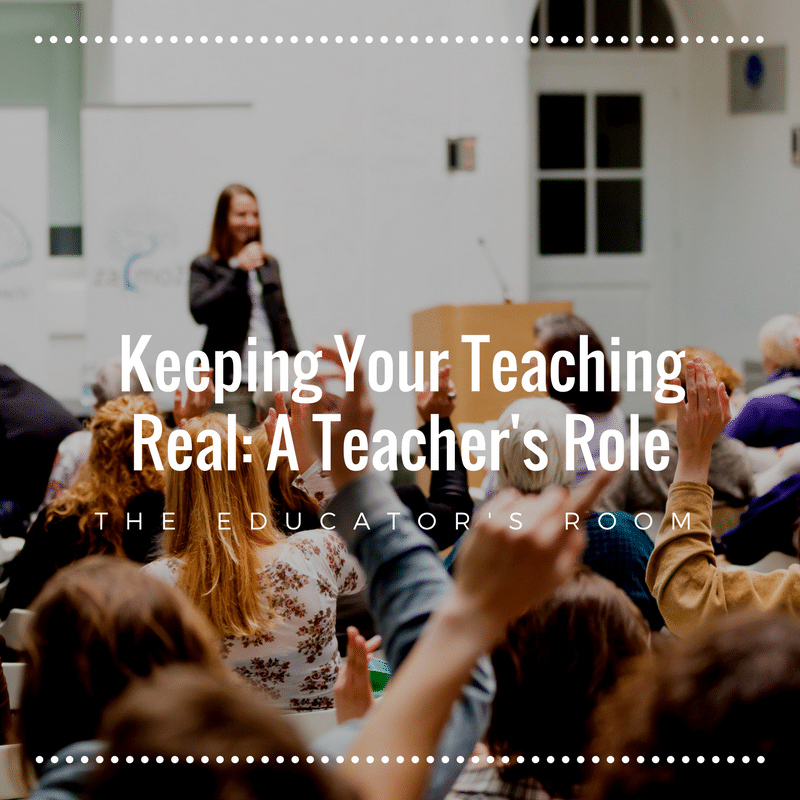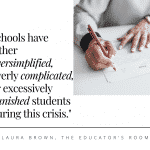Education has slowly been changing over the last decade. Classrooms are becoming student-centered and the teacher’s role is changing. While I am very comfortable giving my students choice and voice in my classroom, sometimes I feel lost while they are working. What is my role? How do I know I am meeting their needs? How do I share my time with all students working being able to balance helping my lowest and challenge my highest? In my 22 years of teaching the role of the teacher has changed from direct instructor to classroom facilitator.
When I began teaching in the public school system, the teacher was the holder of knowledge. Their job was to share information with students while students “learned” from them. Historically classrooms have been set up in rows with a chalkboard as the focal point. Lessons began with the teacher sharing information and students repeating this information. The educator’s role slowly changed as guided reading, writing workshops, guided math and MTSS have developed over the past 20 years. We are slowly shifting the idea of learning to student-centered classrooms. This changes the role of a teacher and shifts the responsibility of learning from the teacher to the student.
Today’s Classroom
My classroom has morphed as my teaching has evolved. I have areas for learning with only 3 desks in the room. We have a tall table, coffee tables, theatre chairs, and long tables for groups to collaborate and plan together. Students are working on objectives and standards I set with my grade level team guided by our standards from the state. They use these to guide their learning through our curriculum. Students set goals and work on individual tasks for increasing their learning. They are often working in groups or individually on their learning and projects. Direct instruction is less and group work is more. My role has shifted.
So, what is the teacher role today? Teachers have a responsibility to ask questions, guide learning and provide opportunities for students to reflect and give feedback to each other. There are a few things I have found that help me with these new tasks.
Asking Questions
As students are working they will hit a wall, they will stall, they will struggle, they will have disagreements with their group. This is your opportunity to ask questions to prompt them in their journey. What do you know? What have you tried? What could you do differently? When have you seen something like this before? Asking questions to help students make connections to their prior learning and scaffolding their thinking to help them process through the steps they have tried will help with their learning. When students are learning, be sure to take advantage of asking them questions to guide them to the next level.
Teaching students to ask questions is another important piece. We talk about Bloom’s taxonomy in my fourth-grade room. I use questions stems to help students develop higher level questions. During the beginning of the year, we practice writing questions during read aloud and I model higher level thinking/questioning. These processes all help students strengthen their ability to questions. When groups are working they have access to question stems which help them in group work. When students are able to ask higher level questions their learning will increase.
Guiding Learning
How do you touch base with every student equally? Often times in my classroom “equal” is not “equal”. I have students who are working above grade level and proficient in independent study skills. They are able to complete tasks and make gains with very little assistance from me. Other students struggle to work independently; they need more guidance in reading or writing, or they are unorganized in their study skills. Each of these learners have different needs and therefore the support they need from me is different as well.
[bctt tweet=”Often times in my classroom “equal” is not “equal”. I have students who are working above grade level and proficient in independent study skills. ” username=””]
Google Keep is the perfect tool to help with guided learning. This chrome extension/app allows me to make a list of my classroom students. On my li, t I have students who need more guidance listed multiple times, up to three, so I am certain to touch base with them more often. I have a student working on persistence and growth mindset so I have listed her twice with “persistence” beside her name once. I have a student who has had some changes at home who needs extra love. He has a second name with “positive” beside it on my list. Structuring my list to show what each child needs allow me to give them equal support.
When I touch base with my students, ask them questions to prompt their learning or stop by their group I am able to check them off the list. The check simply means I have talked with them, offered praise, given help or modeled the work. Once checked, Google Keep moves them to the bottom of the list and I only see those I need to focus on. After I have checked everyone and completed the list, it is a quick and simple process to uncheck all students and restart my process. This has opened up my teaching in so many ways allowing me to focus my efforts on all students. It is s quick and efficient way to know I have worked with everyone. Guided learning is an engaging method which allows me to work with all students giving them what they need at their instructional and behavioral levels.
Assisting Reflection and Feedback
Reflection is an important part of learning. Helping students reflect and giving them positive feedback is another role that has gained importance in education. There are many things at our fingertips now that allow teachers to help students with reflection and feedback in the classroom.
Time is hard to find in our world. Flipgrid is a quick way for students to reflect or give feedback in the classroom. You can create one grid for free and allow students to have unlimited responses (15-90 seconds long) to the prompts you create. Of course a paid version will allow you more classes and options, but you can get what you need from the free version. Flipgrid allows students to reflect on their goals, give feedback on how projects are working, or answer quick questions you pose for thought and learning. This feedback will allow you to structure the next days lessons and small groups.
Student driven portfolios allow students to showcase and celebrate their learning. We use Seesaw in my fourth grade classroom to share and give feedback on work. You are one person, training your students to give meaningful feedback opens up the opportunities for growth and learning in your classroom by allowing students to provide feedback and give help to each other. The free app allows families the ability to view and interact with work as well, giving meaning and an authentic audience to your classroom. Finally this has magnified the collaboration and global impact of our work. Seesaw allows for reflection and feedback in a simple, quick way.
The teacher’s role has changed. We are the facilitator, encourager, goal measurer, questioner and guide to the learning in our classrooms. Teaching in a student centered classroom allow the teacher to build individual bonds with students and there are tools you can use for this role. Question, guide and provide feedback for their learning. You will learn something along the journey as well.







Lori Rice,
First thank you so much for your service. I truly believe that you are essential to our nation’s future. Again thank you for your service and your article.
I agree with you about the evolution in our profession. It, in my opinion, is a good change. Also thank you for providing specific action items and tools to help make this happen. It is refreshing to hear this rather than theory only.
I would like to offer another tool that I built and some teachers are using. It is called TeachersInTouch and will help reduce paperwork and red tape so teachers can spend more time on teaching. Please check it out at http://www.goteachersintouch.com and share your thoughts with me.
Again thank you so much for your service.
Hajj
#SoTeachersCanTeach #TeachersInTouch #ALLIn4Teachers
http://www.goteachersintouch.com